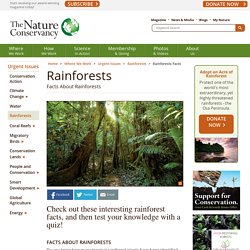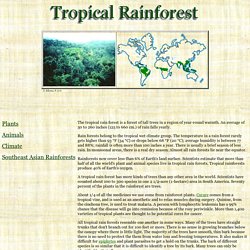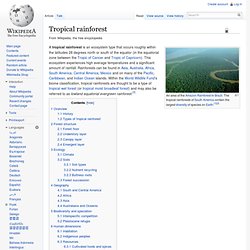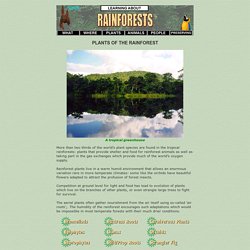

Interesting facts. Rainforests Facts. Facts about Rainforests Do you know how many tropical rainforest plants have been identified as having anti-cancer properties?

Or how many continents around the world contain rainforests? And just how quickly are the world's rainforests disappearing? Find out the answers to these questions and more as you check out these interesting rainforest facts! And when you think that you know all there is to know about the rainforest, test your knowledge with our rainforest quiz.
Rainforest Biomes. The tropical rain forest is a forest of tall trees in a region of year-round warmth.

An average of 50 to 260 inches (125 to 660 cm.) of rain falls yearly. Rain forests belong to the tropical wet climate group. The temperature in a rain forest rarely gets higher than 93 °F (34 °C) or drops below 68 °F (20 °C); average humidity is between 77 and 88%; rainfall is often more than 100 inches a year. There is usually a brief season of less rain. In monsoonal areas, there is a real dry season. Rainforests now cover less than 6% of Earth's land surface. Facts on the Rainforest. Rain 3. Tropical Rainforest Biome Facts. The Equatorial Climate. The average temperature in the rainforest is about 30C, 80F it changer very l... Tropical Rain Forest. Weather in the rainforest. Climate. A tropical rainforest is an ecosystem type that occurs roughly within the latitudes 28 degrees north or south of the equator (in the equatorial zone between the Tropic of Cancer and Tropic of Capricorn).

This ecosystem experiences high average temperatures and a significant amount of rainfall. Rainforests can be found in Asia, Australia, Africa, South America, Central America, Mexico and on many of the Pacific, Caribbean, and Indian Ocean islands. Within the World Wildlife Fund's biome classification, tropical rainforests are thought to be a type of tropical wet forest (or tropical moist broadleaf forest) and may also be referred to as lowland equatorial evergreen rainforest.[3] Overview Tropical rainforests can be characterized in two words: warm and wet. Tropical rainforests are among the most threatened ecosystems globally due to large-scale fragmentation due to human activity. History Tropical rainforests have existed on Earth for hundreds of millions of years. Forest structure Ecology. Plants in the Rainforest. Ten Amazing Rainforest Plants. Our surroundings are sometimes taken for granted.

Even something as unique as the rainforest is forgotten. It seems a little bit of knowledge and a shove in the right direction can get people to appreciate the environment. So, why not start with the wonder that is the rainforest? Even though rainforests only cover less than two percent of the Earth’s entire surface area, they are home to 50 percent of the plants and animals. They are also found on every continent, except Antarctica. You’re probably thinking “I know all there is to know about bananas; I eat them for breakfast and can make delicious banana bread.”
Habitation: Found in Central America, South America, Africa, Southeast Asia and non-tropical regions like the United States thanks to modern agricultural technologies. Dealing with Dangerous Jungle Plants. The Plants of the Rainforest. A tropical greenhouse More than two thirds of the world's plant species are found in the tropical rainforests: plants that provide shelter and food for rainforest animals as well as taking part in the gas exchanges which provide much of the world's oxygen supply.

Rainforest plants live in a warm humid environment that allows an enormous variation rare in more temperate climates: some like the orchids have beautiful flowers adapted to attract the profusion of forest insects. Competition at ground level for light and food has lead to evolution of plants which live on the branches of other plants, or even strangle large trees to fight for survival. The aerial plants often gather nourishment from the air itself using so-called 'air roots';. Earth Floor: Biomes. Tropical Rainforest: Plants Although tropical rainforests receive 12 hours of sunlight daily, less than 2% of that sunlight ever reaches the ground.

The tropical rainforest has dense vegetation, often forming three different layers--the canopy, the understory, and the ground layer. Frequently, people think of the tropical rainforest as a "jungle" where plant growth is dense even at ground level. However, the canopy created by the tall trees (100-120 feet) and the understory, prevents sunlight from reaching the ground.
The soil is, therefore, always shaded, and very little vegetation is able to survive at ground level. Vegetation can become dense at ground level near riverbanks and on hillsides. Plant adaptation Plant survival in a tropical rainforest depends on the plant's ability to tolerate constant shade or to adapt strategies to reach sunlight.
Competition for sunlight by plants is sometimes deadly. Back | Next. Fact sheet: Tropical Rainforest Animals. Where can you find an antelope the size of a rabbit, a snake that can fly, or a spider that eats birds?

All in tropical rainforests, of course! Tropical rainforests are home to the largest and the smallest, the loudest and the quietest of all land animals, as well as some of the most dangerous, most beautiful, most endearing and strangest looking animals on earth. You've probably heard of some of them: jaguars, toucans, parrots, gorillas, and tarantulas all make their home in tropical rainforests.
Rainforest Animals. Rainforest Animals. Baboon Facts - Facts About Baboons. Rainforest Animals.